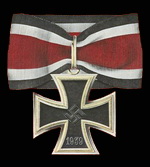

Luftwaffe leader Viktor von Lossberg Loßberg
Luftwaffe leader Viktor von Lossberg Loßberg

Viktor von Lossberg was a Knight's Cross recipient
Photo 01: Lossberg, Viktor von: Oberstleutnant, Ritterkreuz (RK), Luftwaffe, Oberst, Bundesrepublik Deutschland 1941-10-17
Viktor von Loßberg Luftwaffe Major III./Kampfgeschwader 26 17 October 1941
The Knight's Cross of the Iron Cross (German: Ritterkreuz des Eisernen Kreuzes) and its variants were the highest award in the military of the Third Reich during World War II. The Knight's Cross of the Iron Cross was awarded for a wide range of reasons and across all ranks, from a senior commander for skilled leadership of his troops in battle to a low ranking soldier for a single act of extreme gallantry.
The Heinkel He 219 Uhu test
The Heinkel He 219 Uhu (Owl) was potentially one of the Luftwaffe's best and most effective night-fighters but suffered from the misjudgements of senior members of the government and the Luftwaffe (most notably Generalfeldmarschall Erhard Milch, Inspector General of the Luftwaffe, who took over from Ernst Udet when the latter committed suicide in November 1941) as did many other programmes, such as the Me262. Despite the aircraft being fast, manoeuvrable and having devastating firepower, proving itself the equal of Allied fighter-bombers such as the de Havilland Mosquito, Milch succeeded in having the programme abandoned in favour of the Junkers Ju388J and the Focke-Wulf Ta154.
Major Werner Strieb, competed against a Junkers Ju 188S flown by Oberst Viktor von Lossberg and a Dornier 217, which retired early. The He 219V2 acquitted itself well in the trials, so much so that the 'off the drawing board' order for 100 was increased to 300. Additional prototypes were constructed to run in the development programme, including a fourth which was equipped with the FuG220 Lichtenstein SN-2 radar, while production got underway at Rostock, Vienna-Schwechat as well as Mielec and Buczin (both of which were in Poland). From April 1943, a small number of He219A-0 preproduction aircraft were flying with 1 / NJG1 at Venlo in Holland and on the night of 11/12 June 1943, Major Streib shot down five Avro Lancasters in a single sortie. The first six operation sorties resulted in claims of some twenty British aircraft being downed, including six Mosquitoes. In December 1943, Milch suggested that the entire He219 programme be discontinued in favour of the Ju88G. Milch's main objection was that the He219 would be disrupting production lines at a critical time and that the performance of the Junkers was sufficient to take on bombers such as the Lancaster and Halifax. The major flaw in this argument was that the British had begun to use Mosquitoes to escort their night bombers and the Junkers was incapable of combating this superb British fighter-bomber. He initially put forward three proposals that firstly, that Heinkel should abandon the He219 altogether in favour of the Junkers Ju88G and Dornier Do335; secondly that He219 production was reduced in favour of the Ju88G; and thirdly production of the He219 should go ahead as planned.
Web Reference: http://www.historyofwar.org/articles/weapons_he219.html

